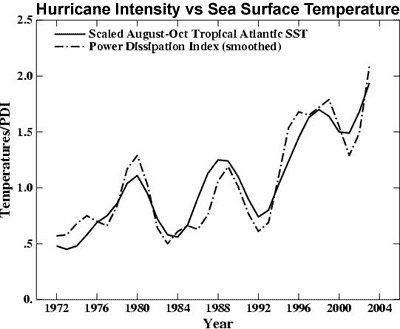Hurricanes that sweep the US may be caused by climate change

NOAA (National Oceanic and Atmospheric Administration)
This graph displays the correlation between water temperature and hurricane intensity.
September 26, 2017
The intensity of Hurricane Harvey, Hurricane Irma, and the threatening Hurricane Jose have been linked to climate change. Hurricane Harvey has devastated Houston, TX with 51 inches of rainfall, a record for the United States, and many scientist accredit the severity to climate change. Atmospheric expert Andreas Prein links the warming atmosphere to a higher rate of evaporation, “Think about an ocean as an infinite supply of moisture,” Prein says. “Harvey is sucking it toward land and dumping it on Texas.”
Hurricane Irma has been the most intense hurricane since Katrina in 2005. This category 5 hurricane killed more than 100 people in Florida and the Caribbean and costing more than $60 million.
At the U.S. government’s 2018 National Climate Assessment the hurricanes were a hot button issue, “in coming decades, predictions based on warming suggest that average-intensity tropical cyclones—Atlantic hurricanes included—will likely get more intense,” said hurricane expert Kerry Emanuel.
Climate change not only affects hurricanes in the US, but all around the globe the intensity of other weather events are increased.
According to oceanography and meteorology teacher Don Hart, California is having one of its worst drought and fire seasons in history also, India is having its worst monsoon season in history and 18 million people are displaced.
Although this theory that climate change is directly correlated to the intensity of hurricanes is still a theory, many statistics prove that they are related. The Bahama’s water are now 90 degrees Fahrenheit, which not only fuels the hurricane but kills the coral reefs.
“Hurricanes increase 2-3% every degree Celsius the water increases,” said senior Laura Grabarczyk.

